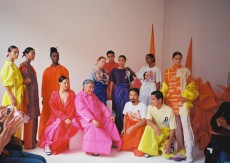.nl Issue: 移民の物語を映像とファッションで伝え続ける、日本とオランダのハーフとして生まれたデザイナーのLisa Konno/Interview with designer, Lisa Konno
NeoL / 2020年3月12日 19時0分
.nl Issue: 移民の物語を映像とファッションで伝え続ける、日本とオランダのハーフとして生まれたデザイナーのLisa Konno/Interview with designer, Lisa Konno
photo by Laila Cohen
オランダのクリエティヴ業界を盛り上げているアーティスト12人を取り上げる「Dutch Creatives」特集。近年、多くの国が国境を閉鎖しナショナリズムが高まり、世界共通の言語でもあるアートを通して団結することが以前よりも重要となってきている。NeoLでは、現在の状況と予測不可能な未来のために、議論ができる空間を様々な形で人々に提供するアーティストやアクティビストへのインタビューに取り組み続けている。本特集では、限界に挑み続け、フロントランナーとして走るオランダに在住するアーティストを紹介し、国の魅力についてはもちろん、今現在の環境、社会構成、政治などの問題を乗り越えるために必要とされる緊急性と行動力を喚起したい。
日本とオランダのハーフとして生まれたデザイナーのLisa Konnoは西洋からみた日本の文化に魅了されてきた。2017年に、元空手世界チャンピオンの父親である“NOBU”こと信広が日本からオランダへ移住した時期の経験を描いたショートフィルム、また同時に日本とオランダの双方の文化の特徴となる要素を取り入れたファッションコレクションを制作。そして次なる試みとして、移民についての物語を伝え続けたいという思いから『Baba』を生み出した。トルコからオランダへ移住した主人公Ceylanの現実を撮影した映画の中では、日本の移民と比べ、トルコの移民に対する態度の違いも浮き彫りになっている。彼女の作品の礎となるストーリーについて聞いてみた。(→ in English)
ーー『NOBU』のコレクションを代表する一着は大きなピンク色のレインコート。オランダのレインコートから形を取り、裏地は着物の生地を用いて制作されていますが、この二つの要素を組み合わせた理由を教えてください。
Lisa「父からの影響が強いです。毎日大きなレインコートを着て仕事に出勤している姿を見ていて、すごくオランダ人っぽいと思っていたんです。でもその一方で、日本で過ごしていた時の思い出も大切にしているので、そんな彼を表現するためには二つの文化の要素を融合することが大切だと思いました。そこで古い着物を解体してレインコートの裏地として使ったり、他にも父の引き出しに埋もれていた空手のT-シャツなども取り入れて作ったんです。あとは、多くのデザイナーが容易に使ってしまいそうな、日本やオランダと聞いてすぐに連想されるデザインや民族服(着物、浴衣)、チューリップなどのデザインをわざと取り入れています」
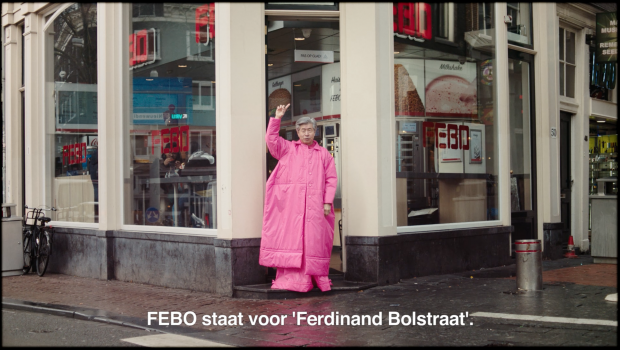
NOBU film by Sarah Blok & Lisa Konno
ーー着物のデザイン、生地や柄などの要素にインスパイアされ、多くの西洋デザイナーがコレクションに取り入れていますよね。中でもマルジェラが足袋に近代的なデザインを加えTabiブーツを発表した時は衝撃を受けました。他に日本の民族衣装を基盤として流行りそうなアイテムはあると思いますか?
Lisa「下駄なども近代に合うよう少し手を加えれば流行るのではないかと思います。日本古来のファッションの要素はほとんどの西洋のデザイナーがコレクションに取り入られていると思います。着物を支える布でできた帯、簪などももう何回も繰り返し使われてきていますよね。そのために『NOBU』を制作する以前、日本の伝統服を取り入れたコレクションを行うに対して躊躇した時期もありました。けれど、父親の移住プロセスを描いたパーソナルなストーリーと結び付ければ、やりすぎとも思われそうなほどに日本の伝統のファッションをフィーチャーしたコレクションを制作できるとのではないかと考えました」
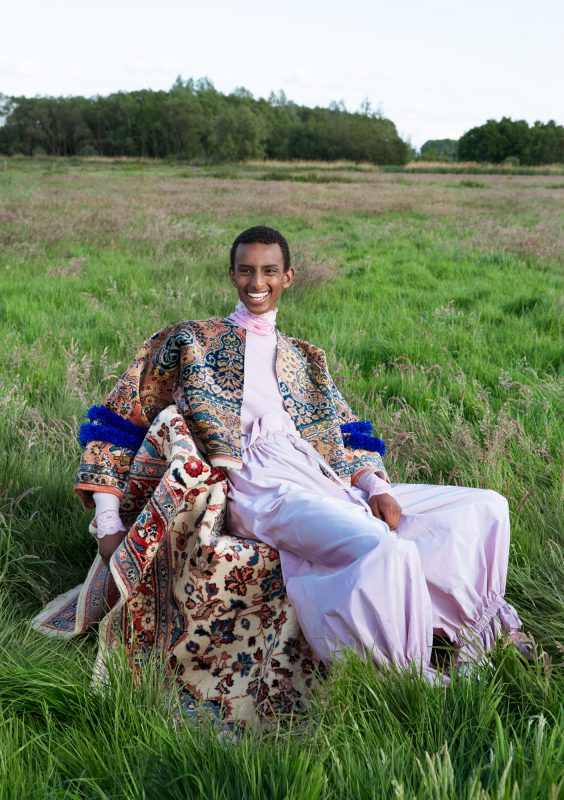
photo by Laila Cohen
ーー『Nobu』に続く第二編となる『Baba』はトルコから移住してきたCeylan Utluの移住過程を、ファッション、映像、写真の媒体を掛け合わせて描いたプロジェクトです。Jeylanに出会ったきっかけを教えてください。
Lisa「大元には、私の父親であるNobuを始め、違う国籍をもつ移民たちの父親の移住する過程を描く作品を作りたいという思いがありました。出会いでいうと、どちらの作品も脚本と監督を務めたSarah Blokと一緒に制作したのですが、彼女の友人がCeylanの娘だったんです。Sarahは友人からCeylanの話をたくさん聞いていて、彼がとても魅力的な人物だとわかったので出演を依頼し、快くOKをもらうことができました。Ceylanは、私の父親であるNobuとは真反対の性格だったのですが、2人の間に共通点を見いだすことができたのが面白かったですね。国籍が異なるので、遭遇する問題やコンプレックスが異なり、社会がトルコからの移民にとる態度と日本からの移民の扱い方の違いがはっきりとわかると思います。またトルコ人は感情豊かなので、歌や詩を通して思いを伝えるCeylanを撮影できたのも良かったです」
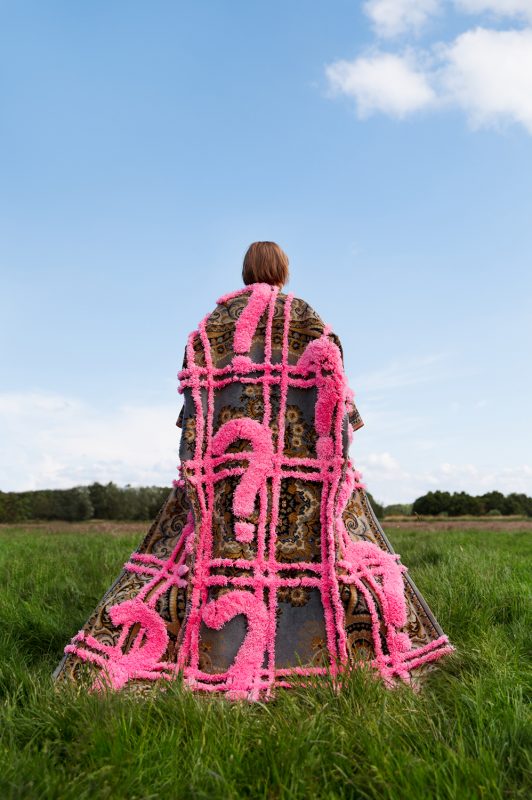
photo by Laila Cohen
ーー Ceylanと自分の父親NOBUが経験された問題やコンプレックスがそれぞれ異なったということですが、特にどのようなことにCeylanは苦労したのでしょうか?
Lisa「例えば、彼の娘との関係ですね。オランダは違いますが、親の世話係としての責任を若い頃から持つのが常識とされる文化がある国は多いのです。しかし、父親が生まれた国の文化とは違った環境で生まれてきた子供にはこの風習を理解することがとても難しい。また、父親の言語と文化を通訳するような役割を子供が持つという体験についてもよく聞きます。特に何かが大変だと言わない彼の性格が、主役として逆に大切な特徴だと思いました。移民の話題はネガティブなイメージを持たれがちですが、このプロジェクトでは移民をより前向きに描きたかったのです。Ceylanは西洋ではまだレアとされていた音楽を演奏するミュージシャンとして、移住の際にはあたたかく歓迎されたようですが、そのために余計に現実よりもエキゾチックなイメージを持たれがちでした。そして私の父親と比べ、Ceylanはオランダ語が流暢だったためにより受け入れられやすかったということもあります。その国の言語を話さなくても良い場合もありますが、ある国の文化にどのぐらい溶け込めたのかという測りとして言語力が考慮されることが多いので、彼がオランダ語を話せたのは受け入れられた大きな理由の一つでもあったと思います」
ーー日本とオランダの両国籍をもつハーフとして、いずれかの文化と自分との断絶を感じたことはありますか。
Lisa「周りからは日本人として見られていなかったのでオランダでは問題はありませんでした。酷くても、アジア圏の固定概念に対するジョークなどを言われるくらいでしたね。逆に日本の文化に触れた時の方が、アウトサイダーと感じたことが多かったです。幼少期は週末に補習校に通っていたのですが、他の学生はみんな私より読み書きができ、居場所がないと感じていた頃もありました。しかしひどい差別などは受けていないので、むしろ両国籍をもつことで“常識”の意味を広げてくれたように感じます」
ーーオランダに住んだことで、日本の文化の魅力をより感じるようになったということはありますか。
Lisa「日本の文化を客観的に観察していたぶん少しはそういうことがあるかもしれませんが、本当に魅力を感じだしたのはここ最近です。今はダイバーシティ(多様化)や文化の盗用(cultural appropriation) と評価(cultural appreciation)の違いを判断するのが難しくなってきている時代です。だからこそ特に“西洋から見た日本”に大変に興味があります」
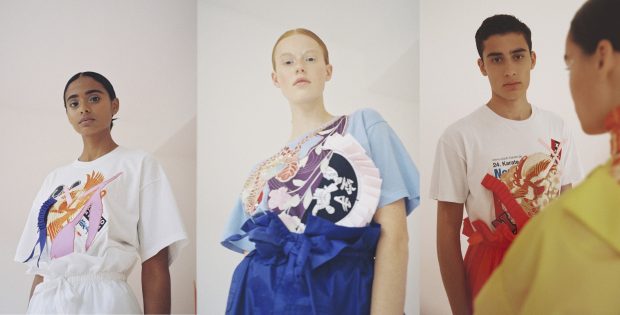
photo by Laila Cohen
Artezを卒業後、ファッション界の問題を訴えるプラットフォームとしてランウェイを活用。2015年には、ZaraやH&Mなど多くのファストファッション業界を代表する会社の下請けとされていたバングラデシュに位置する工場rana plazaが崩壊し、多くの労働者が死亡したダッカ近郊ビル崩落事故の写真を拡大することによって、コレクションの服の柄として利用。一目で見れば美しいが、近づけば全く違うというファッション業界を指した比喩表現として使用したのだ。2016年に発表されたコレクションYours TrulyはH&MでTシャツが売られている同じ価格の20ユーロで彼女が考えた柄(Pattern)つきの生地のみが買えるPattern package を行う。H&Mなどの店で売られているTシャツと同じ価格で生地だけを売ることによって、消費者に20ユーロなどで売られる服の価格には、制作するために必要とされる労働力の価値が考慮されていないというメッセージを送った。
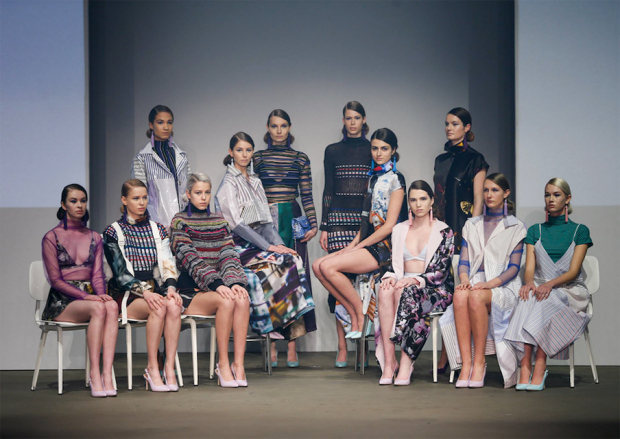
photo by Team Peter Stigter
ーー様々な作品を通して、ファッションが、着用する衣類だけではなく、幅広い意味を持つという考えを推奨してきたと思いますが、これらのプロジェクトが完成するまでのクリエティヴの過程を説明していただけますか。
Lisa「Artez在学中は、ファッション業界で働きたいけど大量生産と労働者を搾取し続ける体制を支援したくないという強い意志を持っていました。その思いから、卒業後はランウェイを生産または消費方法を改善して覆すことを訴える場所としての活動を始めました。なるべく多くの人にこの問題について意識してもらうことから始まり、意識が高まった時点でそこから消費者を参加させられる方法を考えた結果、どのくらいの労働力が洋服一着を作り上げるために必要とされているのかを教えることが大事だと思ったのです。そこからパターンパッケージのアイデアが湧きました。5ユーロで売られているTシャツなどの真の価値を問い直して欲しかった。パターンパッケージはH&Mで売られているTシャツの価格と同じ20ユーロで、私がデザインした柄の生地のみを販売しました。購入された方が自ら服を縫い合わせないといけなかったのです。アイデアだけで20ユーロかかるなら、制作する労働力を換算すればたった20ユーロで服を売るのはバカらしいというメッセージが込められています」
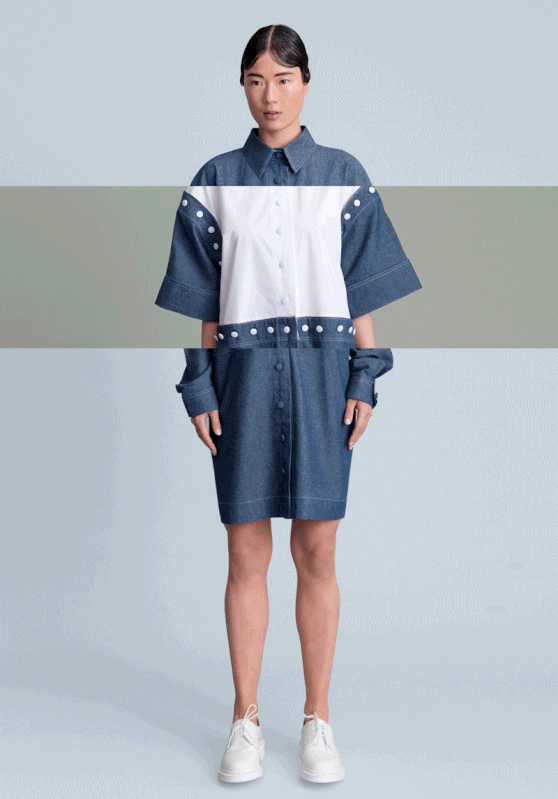
Photo by Peggy Kuiper
Lisa「プロジェクト『Collect』は流行など関係なく長持ちする一品を作りたいという友人であるKarin Vlugの発想から生まれました。時代に沿ってトレンドやスタイルが変わることに魅力を感じるからこそファッションが好きな人が多いと思いますが、常に斬新でフレッシュな服を、大量な生地を無駄にせずに生産できる方法はないかと考えたんです。そこからイケアやレゴブロックなどの会社の特徴とされている部品替えのコンセプトを取り入れました。人は自分が完成に貢献した気持ちがあるともっと物を大切にする傾向があるので、ベースの色だけ、または袖のデザインや幅などの一部分を変えられるという主導権を与え消費者も制作過程に参加できるようにしました。ファッションはストーリーを伝える力があることも忘れてはいけません。最新プロジェクトの『Baba』と『Nobu』はファッションを通してストーリーを伝えたい気持ちが込められています」
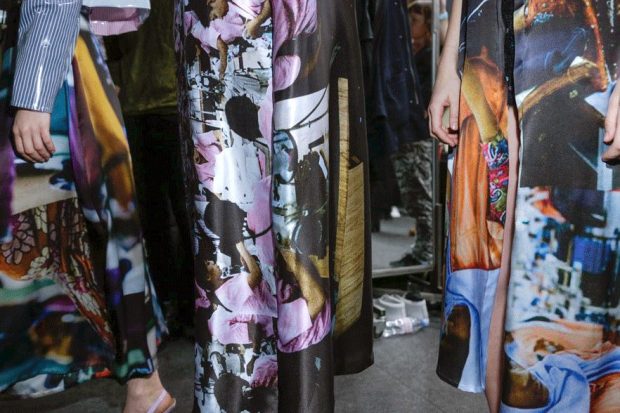
photo by Team Peter Stigter
ーー持続することの可能性を訴え続けていますが、政府、消費者または大手の企業が一番意識しなければいけないことは何だと思いますか。
Lisa「ファッションはグローバルで広範囲に渡る業界なので、透明性を求めるのは難しいと思います。とはいえ政府はファストファッションなどの企業の透明性を訴える重大な責任を持っています。例えば、ファストファッションの下請け工場をヨーロッパに移す政策など。H&MやZARAなどのメジャーブランドの服の裏地が作られている工場はコートにボタンをつける場所とは全く違うことが大半ですが、一着を作るために服がどの工場にいき渡るのかを把握していないブランドが多いため、工場の労働条件やプロセスに手を加えられないのです。責任を持ってプロセスの最初から最後までの過程を管理することから変化が加速すると思います」
text Ayana Waki
Lisa Konno
Lisa Konno graduated at the Fashion Design department of Artez in Arnhem. Currently based in Amsterdam, she continues to experiment with new ways and techniques to develop fashion.
http://www.lisakonno.com/home/
https://www.instagram.com/lisakonno/
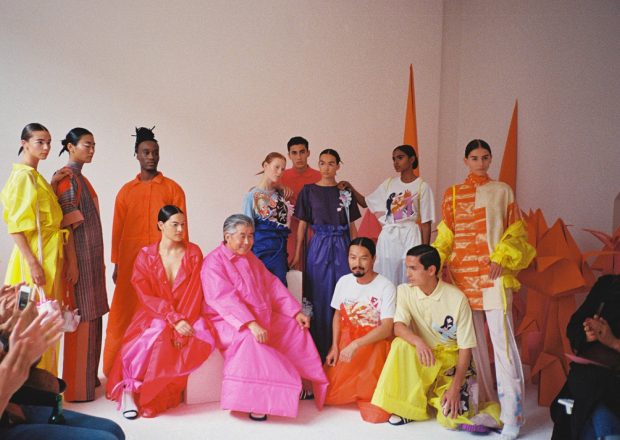
photo by Laila Cohen
Diversity and culture can be a touchy subject. As more designers take inspiration from different cultural heritages, it is becoming increasingly hard to distinguish the fine lines between appropriation and appreciation. For designer Lisa Konno however -born and raised in the Netherlands with a Japanese father- the subject of culture and the way it is perceived has become a recent fascination in her life. Nobu, a multidisciplinary project which combines fashion, film and photography to tell the story of her father, a former karate world champion is an ode to the times of difficulties but also the times of laughter during his cultural migration process. Her most recent project Baba, is the second part of this project; telling the story of Ceylan Utlu, an immigrant of Turkish heritage.
-In your project 'Nobu',the most recognizable piece from the collection is the oversized pink raincoat, its form taken inspiration from a dutch raincoat and the inside lining of it the fabric of a kimono. What was the creative process behind combining these specific elements from two different cultures?
Lisa: For the collection I took a lot of used kimonos and the lining of them because kimonos are made from these squares and so I used them for the lining of the raincoat.
For the entire collection, the inspiration came from my dad himself and his closet so the items he wears. A raincoat is something that is very Dutch about him that he cycles to work in this big rain poncho everyday. But he also has all of these Japanese T-shirts and so those shirts I used for the collection are items very personal to his specific story. And then there are also things I used that are not necessarily specific to him but are more cultural cliches, things that are almost overly used when it comes to Japanese designs that I purposely used. The tulips were cliches from Dutch culture so it was kind of a mix of both.

NOBU film by Sarah Blok & Lisa Konno
-One Japanese fashion cliche that many designers incorporate into their collection is obviously the garment structure, fabric and pattern of a kimono, but designers such as Maison Margiela have taken a less commonly used piece such as the tabi and redesigned it with a modern twist creating the Margiela tabi boots. What are some other Japanese fashion items do you think could be altered in recent times and become a trend?
Lisa: I think a lot of it is already heavily used and done. The geta shoes for instance, I think is also something that can be globally used and altered in a different way to suit these times. But it’s also been done before. That was why I was hesitant to use Japanese traditional clothing as inspiration because it almost felt like it was overused and kind of a cliche, put on a pedestal by the west even. So I wanted to stay away from it before making 'Nobu'. I thought the only way for me to use them was if they were on a personal level and not about Japanese craft or design but a personal aspect to describe something about my dad as a person. And his story of integration.

photo by Laila Cohen
-Baba is the second part of your extended multidisciplinary project the first being 'nobu' which tackles the topic of migration which plays a huge role in the protagonist Ceylan Utlu’s life. What drew you to Ceylan Utlu’s story that made you want to make him the protagonist of your next project?
Lisa: I made the project together with Sarah Blok, a theatre writer and film director. One of her close friends is the daughter of Ceylan. We of course started with my own father, Nobu and so the whole project started with me and Sarah working together and thinking about this concept. Then we already had in mind to expand it about these different dads with their different nationalities. So when Sarah heard a lot of stories about Ceylan, we thought he would be a nice character for the sequel because he sounded very interesting and charismatic, peculiar and had his own way of telling stories. We had some coffee whilst we talked and heard about his life story and it sounded like something that would be interesting for the sequel. We just asked him and he was very into it. I think the most interesting thing was that he was very different to my dad, Nobu but there are also similarities. Culturally the way he expresses himself is different and of course they have completely different life stories. The troubles and conflicts but also the funny things that occur with cultural misunderstandings are handled in a different way and I guess society looks at a Turkish immigrant differently to a Japanese immigrant. The way he talked about it was very interesting and I think Turkish culture is in general more expressive and emotional so he was talking much more in songs and poetic ways. That was what was interesting about him. Made a good story about him.

photo by Laila Cohen
-You mentioned that Ceylan and your father Nobu found different things difficult during the migration process. Can you tell me what Ceylan specifically found hard about the migration process?
Lisa: He doesn’t express anything particularly hard. I think that’s also something we wanted to find in our subjects. We thought that a lot of portraits about immigrants are very negative so we wanted to have a light hearted portrait about the immigrants and the things that are good. Of course they have some difficulties but in general I don’t think they would describe it as hard. I guess the difficulties are a lot in the relationship between him and his daughters for example. I feel like many cultures outside of the Netherlands are more prone to shift the role to take care of their parents earlier on in life and I think that is also the case in Japanese culture where the mum still lives with the eldest son but I guess it was emphasized about this part about migration and about having his child growing up in a different culture. Because the child becomes in terms of the language and the culture, the translator to the dad so I think that that was something they had experienced. I think Ceylan was welcomed when he arrived in the Netherlands because he was a musician. It was very new here to have this type of music and so he was accepted with open arms. But he also thought that he was painted as more exotic than he was, more in a stereotypical way but in a positive sense. I think my dad doesn't really speak Dutch well but Ceylan does, he is very eloquent. And I also think that that is something to do with what we accept and how we measure if someone has successfully integrated into a new culture.
-As a person of different cultural backgrounds, hafu born and raised in the Netherlands, was there ever a time when it was hard for you to fully identify yourself in both cultures?
Lisa: I’ve never had trouble in the Netherlands. I think because I lived here and many people didn’t see me as Japanese for instance. If they did it was never a negative thing, maybe there were some jokes about stereotypes but not really. It was more the other way around. As an outsider in Japanese culture. I went to a Japanese school during childhood on the weekends and there they were much better speaking and writing in Japanese and I felt more of the negative side of being a hafu. More like an outsider. But it hasn’t brought that much difficulties. I’m glad that I was brought up by different cultures because it has broadened my perspective on what is normal and so it has given me more eyes.
-As you have lived in the Netherlands all of your life but having a mixed cultural heritage, did that increase your fascination towards the Japanese culture in a sense?
Lisa: I guess because I am not examining Dutch culture as much as I am examining Japanese culture in my perspective because I don't live there but my fascination towards Japanese culture only grew when I got older during the last couple of years. And I think now because there is much more discussion about diversity and cultural identity and appropriation, I am much more fascinated about the culture. But I guess it’s not a fascination towards the culture itself but how the culture is perceived by the west. That is mostly where my fascinations lies. Other than that it is not really something that I think about.

photo by Laila Cohen
Sustainability is another topic Lisa Konno cares about deeply. During Amsterdam Fashion Week in 2015, Lisa printed out blown up photographs from the Rana Plaza Disaster which devastatingly killed many workers producing clothing for fast fashion brands in Bangladesh and used it as a metaphor for the industry; a garment that is pretty at first glance is not what it seems when looked at closely.
Lisa: When I was graduating my course, I was graduating with the idea that I would like to work in fashion but I don’t want to support the system because they are over producing and exploiting people in factories. So I came up with ways to use the fashion collections to make a statement and suggest ideas I guess of how we can also handle clothes in fashion and consume it.’
Her collection ‘Your Truly’ created pattern packages and sold it for 20 euros, ironically the same amount of money you usually pay to purchase a t-shirt at H&M.
Lisa: ‘I think it first started with creating awareness about this problem and then now that there is awareness I thought what is something that can be done to involve the buyer in the process. I thought educating people on how much work is put into creating a garment is something that contributes to the idea of creating a piece of clothing that can be cherished and not only spend five euros at Primark for and that is where the idea of making a pattern package came from. It was kind of a joke because it cost 20 euros, an average price that a shirt costs in H&M so it was about the fact that you can buy this shirt for 20 euros from me but you only buy the idea and you have to put in the effort and the materials yourself and so that is where that came from.

photo by Team Peter Stigter
‘Collect’ enabled consumers to take part in the creative process so they could personally adjust a part of the clothing to make it customizable.

Photo by Peggy Kuiper
Lisa: ‘The idea came from my friend, Karin Vlug who also had an idea of how we could make something that lasts longer while at the same time not being timeless and boring. Because the idea of being attracted to fashion is about changing and being different in different times and not being timeless and the fact that it changes in a few years so how we could maintain that whilst not exploiting materials. So we thought about this Lego or Ikea way of keeping the base but being able to change the color, the sleeve or the width of it to also involve the wearer more because you feel like more of the designer when you are contributing to it.’

photo by Team Peter Stigter
-What do you think in terms of governmental policies, big businesses regarding their supply chains as well as consumers needs to change the most ?
I think fashion is such a global industry, it's hard to become transparent because there are so many companies in different countries. But I do think there is a huge responsibility for governments to be more demanding when it comes to transparency within companies. For example, encouraging companies to make their products more in Europe. So that is something I think is a big responsibility for the government to do. Aside from that, I think there is a huge responsibility for huge commercial brands like H&M and Zara to have their own factories and have control over their working conditions. Because they work with factories that they don’t own, they just send off work to them and then that factory sends off work to another factory. That is why there is little control over the process. They should take control and only produce in factories that they have control over and that’s the only way to truly change the industry.
text Ayana Waki
Lisa Konno
Lisa Konno graduated at the Fashion Design department of Artez in Arnhem. Currently based in Amsterdam, she continues to experiment with new ways and techniques to develop fashion.
http://www.lisakonno.com/home/
https://www.instagram.com/lisakonno/
関連記事のまとめはこちら
https://www.neol.jp/fashion/
この記事に関連するニュース
-
「自分にとって何が大切なのかを知ることができた」Jamie xx “In Waves”インタビュー
NeoL / 2024年9月16日 17時0分
-
Message from Anna Umemiya: “I began treatment for breast cancer on July 31.”
OTONA SALONE / 2024年9月4日 16時30分
-
JETRO and Coolwater announce partnership to bring Fund Accelerator Program to Japan VC ecosystem
PR TIMES / 2024年9月1日 23時40分
-
面接対策から日常会話まで、「日本語のオンラインプライベートレッスン」9月生・10月生の募集を開始!
PR TIMES / 2024年8月31日 10時40分
-
【ミスミ】機械部品調達のAIプラットフォーム「meviy」/ ハンドクレーン業界シェアNo.1のアイコクアルファがmeviyを採用
PR TIMES / 2024年8月30日 13時15分
ランキング
-
1意外と熟睡できる パイプ椅子で“簡易ベッド”作る方法 警視庁が解説
オトナンサー / 2024年9月25日 22時10分
-
2「息吸ってるだけで『空気税』とか言い出しそう」東京23区の“家庭ゴミ有料化”報道に怒りの声も…“ゴミ袋1袋75円”の八王子市では確かな手ごたえ「市民の意識があがった」
集英社オンライン / 2024年9月25日 17時49分
-
3【12星座別☆今日の運勢】9月26日の恋愛運1位はさそり座!感性の近い人との出会いが期待できます
ココロニプロロ / 2024年9月26日 0時5分
-
4スズキ「“2階建て”ジムニー5ドア!?」公開! 大人“4人”寝られる「超広びろ仕様」に? タフスタイルも超カッコイイ「“スゴイ”車中泊」仕様! ホワイトハウスキャンパーが実車展示
くるまのニュース / 2024年9月26日 8時10分
-
5「店長、あいつを辞めさせて」接客が名物の居酒屋なのに…仏頂面であいさつもできない正社員に困っています【社労士が解説】
まいどなニュース / 2024年9月26日 7時20分
記事ミッション中・・・
記事にリアクションする
![]()
記事ミッション中・・・
記事にリアクションする

エラーが発生しました
ページを再読み込みして
ください



